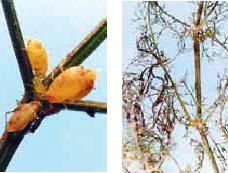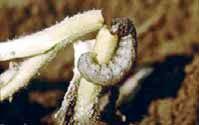Fennel: Insect Pests Management
Fennel: Insect Pests Management
Aphid
Biology: Egg: The females produce wingless off spring which are mated by the males and then lay hard-shelled eggs on the branches. The eggs initially are greenish, but soon turn black. In this form the aphids survive the winter. In Spring the eggs hatch to wingless females which produce winged off spring by parthenogenesis.
Egg: The females produce wingless off spring which are mated by the males and then lay hard-shelled eggs on the branches. The eggs initially are greenish, but soon turn black. In this form the aphids survive the winter. In Spring the eggs hatch to wingless females which produce winged off spring by parthenogenesis.- Nymph: There were three nymphal instars. The first instar nymphs were dull white and became light green in the second instar. The third instar nymphs and adults turned green.
- Adult: Adults are yellow-green in color, dusted with greyish wax. They have short, dusky, slightly swollen, siphunculi (or cornicles) that are about twice as long as wide
- Direct damage: Aphids damage plants by puncturing them and sucking their juices. They damage the young and soft parts of plants, such as new leaves and shoots. Signs of damage are leaves not opening properly and being smaller in size. Severe infestation can cause shoots to wilt and dry out.
- Indirect damage: Aphids have wings and can move from plant to plant spreading viral diseases, picked up from infected plants. Aphids secrete a sugary liquid that stimulates black sooty mold growth. It can cover the surface of leaves which affects the way they absorb sunlight.
- Parasitoids: Lysiphlebus sp, Diaeretiella sp, Aphelinus sp, Aphidius colemani etc.
- Predators: Ladybird beetle, lacewing, spiders, hover fly etc.
Thrips
Biology:- Egg: Eggs are white to yellow, kidney-bean shaped, microscopic in size. Develop within leaf tissue with one end near the leaf surface. Egg stage is 5-10 days.
- Larva: Instars I and II are active, feeding stages. Larvae are white to pale yellow, elongate and slender body. Resemble adult, but without wings. Antennae are short and eyes are dark in color. Crawl quickly when disturbed. Larval stage is 8-10 days.
- Pre-pupa and pupa: Instars III and IV are inactive, non-feeding stages called pre-pupa and pupa. Pale yellow to brown; body more stout than younger instars. Antennae are bent to head; wing buds are visible. Found in the soil, at the base of the plant. Pre-pupal and pupal period is 2-4 days.
- Adult: About 1.5 mm long; elongate, yellow and brown body with two pairs of fringed (hairy) wings. Mouthparts are beak-like and antennae are 7-segmented. Parthenogenic (asexually reproducing) females; males are extremely rare. Feed on young leaves and insert eggs individually into leaves. Adult life span is about 13-15 days month.
- Direct damage: Thrips damage the undersides of leaves by sucking their juices. They damage young and soft parts of plants such as new leaves and shoots. As a result, leaves curl downwards and change to a blackish- silver color. Severe infestation causes young leaves to wilt and dry out.
- Indirect damage: Thrips can carry and spread viral diseases.
- Parasitoid: Ceranisus menes
- Predators: Predatory thrips, minute pirate bug, ladybird beetle, lacewing, mirid bug etc.
Leaf eating caterpillar/gram pod borer
Biology:- Egg: The spherical, yellowish eggs are laid singly on tender parts and buds of plants. The egg period lasts for 2-4 days.
- Larva: Caterpillars vary in colour, initially brown and later turn greenish with darker broken lines along the side of the body. The larval period lasts for 18-25 days. Body covered with radiating hairs. When full grown, they measure 3.7 to 5 cm in length.
- Pupa: Pupation takes place inside the soil. Pupal stage lasts 7-15 days.
- Adult: Moth is stout, medium sized with brownish/grayish forewings with a dark cross band near outer margin and dark spots near costal margins, with a wing expanse of 3.7cm.
- Young larva feeds on the leaves.
- Feed on leaves, shoots and buds.
- Parasitoids: Trichogramma spp., Tetrastichus spp., Telenomus spp, Bracon spp., Campoletis sp, Chelonus spp., Ichneumon spp., Carcelia spp. etc.
- Predators: Lacewing, ladybird beetle, spider, red ant, dragonfly, robber fly, reduviid bug, praying mantis, King crow etc.
Cutworm
Biology: Egg: Each female moth come out at dusk and lay creamy white, dome-shaped eggs (200-350) in clusters of about 30 each, either on the under surface of the leaves of host plants or in the soil.
Egg: Each female moth come out at dusk and lay creamy white, dome-shaped eggs (200-350) in clusters of about 30 each, either on the under surface of the leaves of host plants or in the soil.- Larva: Newly emerged young larva is yellow in colour, 1.5 mm long with a shiny, black head and a black shield on the prothorax. The full-grown larva is about 42-45 mm long and is dark or dark brown with a plump and greasy body. Larvae live in the soil and are yellow or blackish- green in color. They have striped markings running down the sides of their bodies. The larval stage varies from 30-34 days
- Pupa: Pupae are brown to dark brown, about 1.5 to 2.0 cm in length and are usually found in or on piles of leaf mould. Pupation takes place underground in an earthen chamber. Pupal period is completed in 10 to 30 days
- Adult: Adult measures about 25 mm from the head to the tip of the abdomen and looks dark with some grayish patches on the back and dark streaks on the forewings. Adults live for 7-10 days. Total life cycle takes up to 36 days (from egg to adult). The moths usually emerge at night. This pest generally completes three generations in a year.
- Both adult and caterpillars become active at night.
- During the day time caterpillars hide in crack and crevices in the soil.
- They attack young plants by severing their stems, pulling all parts of the plant into the ground and devouring them.
- Plants with severed stems have difficulty growing again.
- This pest can cause serious damage; particularly when crops are at 25 - 35 days after planting.
- Parasitoids: Trichogramma spp., Tetrastichus spp., Telenomus spp., Bracon spp., Campoletis sp, Chelonus spp., Ichneumon spp., Carcelia spp. etc.
- Predators: Lacewing, ladybird beetle, spider, red ant, dragonfly, robber fly, reduviid bug, praying mantis, King Crow etc.
Cigarette beetle
Biology:- Egg: An egg is pearly white, and is not easily seen with the naked eye. When fully grown, beetle larvae is C-shaped (grub-like) and about 3/16-inch long. Female lays about 30 eggs in a period of 3 weeks. Eggs hatch in 6 to 10 days.
- Larva: Larvae are creamy white and covered with long, yellowish-brown hairs. They have a brown head and legs. The larval stage lasts from 5 to 10 weeks.
- Pre-pupa and pupa: The pre-pupal and pupal periods last 2 to 3 weeks and are passed in a cell.
- Adult: Adults are yellowish- to reddish-brown, oval-shaped, and about 1/10-inch long. The head is bent downward sharply, nearly at right angles to the body, giving a humpbacked appearance when viewed from the side. The wing covers (elytra) are smooth, and the antennal segments are uniform and saw-like (serrate). Adults are strong flyers and active in subdued light at temperatures above 65° F. Adult beetles may live from 23 to 28 days. In temperate climates, beetles begin swarming in May and again in August. Overwintering may be passed in the larval stage, with some adults not too resistant to cold hibernating in crevices. There may be 5 to 6 overlapping generations per year in warm localities with only one generation in the more temperate regions. In warehouses, the life cycle may be completed in 52 days.
Drugstore beetle
Biology:- Egg: Females lay up to 75 eggs in the food or substrate.
- Larva: The larval period ranges from 4 to 20 weeks. Larvae tunnel through the substrate and when fully grown build a cocoon and pupate
- Pupa: Pupal period is 12 to 18 days.
- Adult: The beetles are cylindrical, 2.25 to 3.5 mm long, and are uniform brown to reddish brown in colour. Have longitudinal rows of fi ne hairs on the elytra (wing covers). The antennae of the cigarette beetle are serrated (like the teeth on a saw) while the antennae of the drugstore beetle are not and end in a 3-segmented club. The elytra (wing covers) of the drugstore beetle have rows of pits giving them striated (lined) appearance. Adult females live approximately 13 to 65 days. The entire life cycle is generally less than two months but can be as long as 7 months.
- The duration of the life cycle is highly dependent on the temperature and food source. Development occurs between 60 to 93° F (15 to 34° C) but is optimal at about 85° F (30° C) and 60 to 90% relative humidity.
IPM for Fennel
To know the IPM practices for Fennel, click here.
Source: NIPHM and Directorate of Plant Protection, Quarantine & Storage
Last Modified : 12/11/2019
© C–DAC.All content appearing on the vikaspedia portal is through collaborative effort of vikaspedia and its partners.We encourage you to use and share the content in a respectful and fair manner. Please leave all source links intact and adhere to applicable copyright and intellectual property guidelines and laws.
RELATED ITEMS
Chilli insect pests
This topic covers information about Chilli insect...
Fenugreek Insect Pests
This topic covers information about Fenugreek Ins...
Coriander Insect Pests
This topic provides information about Coriander I...
Betelvine Insect Pests
This topic covers information about Description of...
